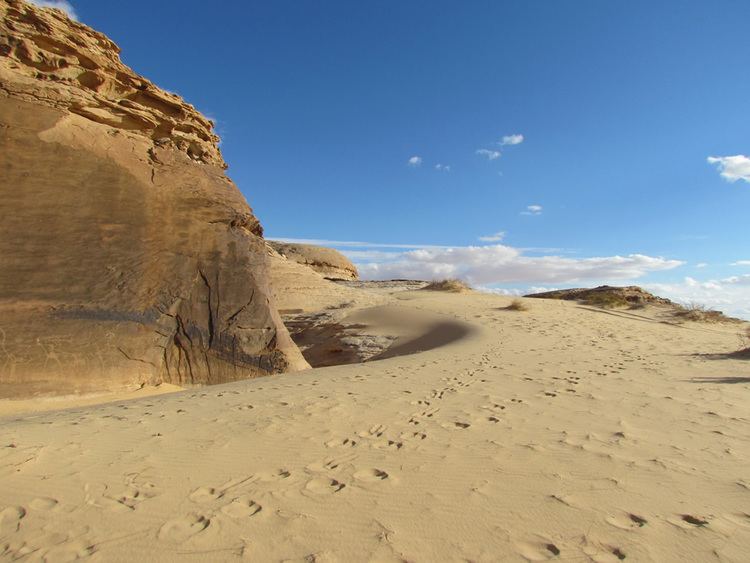Time zone AST (UTC+3) | Province Tabuk province Local time Monday 8:31 PM | |
 | ||
Weather 25°C, Wind SW at 16 km/h, 20% Humidity Neighborhoods At Tijari, Ar Rawdah, Al Qaa, Haddaj, Ar Rabwah, As Safa Points of interest Taima Museum, Karim pomegranate Palace, Emirate Palace old ‑ pomegr | ||
Haddaj well tayma saudi arabia
Tayma /ˈtaɪmə/ (Arabic: تيماء) or Tema /ˈtiːmə/ is a large oasis with a long history of settlement, located in northwestern Saudi Arabia at the point where the trade route between Yathrib (Medina) and Dumah (al-Jawf) begins to cross the Nefud desert. Tayma is located 264 km southeast of the city of Tabouk, and about 400 km north of Medina.
Contents
- Haddaj well tayma saudi arabia
- Map of Tayma Saudi Arabia
- Riyadh to tabuk tayma city north of saudi arabia
- History
- Archaeology
- Economy
- Points of interest
- References
Map of Tayma Saudi Arabia
Riyadh to tabuk tayma city north of saudi arabia
History
Recent archaeological discoveries show that Tayma has been inhabited since the Bronze Age. In 2010, the Saudi Commission for Tourism and Antiquities announced the discovery of a rock near Tayma bearing an inscription of Egyptian pharaoh Ramesses III. This was the first confirmed find of a hieroglyphic inscription on Saudi soil. Based on this discovery, researchers have hypothesized that Tayma was part of an important land route between the Red Sea coast of the Arabian Peninsula and the Nile Valley.
The oldest mention of the oasis city appears as "Tiamat" in Assyrian inscriptions dating as far back as the 8th century BCE. The oasis developed into a prosperous city, rich in water wells and handsome buildings. Tiglath-pileser III received tribute from Tayma, and Sennacherib named one of Nineveh's gates as the Desert Gate, recording that "the gifts of the Sumu'anite and the Teymeite enter through it." It was rich and proud enough in the 7th century BCE for Jeremiah to prophesy against it (Jeremiah 25:23). It was ruled then by a local Arab dynasty, known as the Qedarites. The names of two 8th-century BCE queens, Shamsi and Zabibei, are recorded.
For part of his reign, Babylonian king Nabonidus retired to Tayma for worship and looking for prophecies, entrusting the kingship of Babylon to his son, Belshazzar.
Cuneiform inscriptions possibly dating from the 6th century BCE have been recovered from Tayma. It is mentioned several times in the Old Testament. The biblical eponym is apparently Tema, one of the sons of Ishmael.
According to Arab tradition, Tayma was inhabited by a Jewish community during the late classical period, though whether these were exiled Judeans or the Arab descendants of converts is unclear. During the 1st century CE, Tayma is believed to have been principally a Jewish settlement. The Jewish Diaspora at the time of the Temple’s destruction, according to Josephus, was in Parthia (Persia), Babylonia (Iraq), Arabia, as well as some Jews beyond the Euphrates and in Adiabene (Kurdistan). In Josephus’ own words, he had informed “the remotest Arabians” about the destruction. So, too, in pre-Islamic Arabic poetry, Tayma is often referred to as a fortified city belonging to the Jews, just as the anonymous Arab poet has described:
As late as the 6th century CE, Tayma was the home of the wealthy Jew, Samau’al ibn ‘Ādiyā.
Tayma and neighboring Khaybar were visited by Benjamin of Tudela some time around 1170 who claims that the city was governed by a Jewish prince. Benjamin was a Jew from Tudela in Spain. He travelled to Persia and Arabia in the 12th century.
In the summer of 1181 Raynald of Châtillon attacked a Muslim caravan near Tayma, despite a truce between Sultan Saladin and king Baldwin IV of Jerusalem, during a raid of the Red Sea area.
Archaeology
The site was first investigated and mapped by Charles M. Doughty in 1877. The Tayma stele discovered by Charles Huber in 1883, now at the Louvre, lists the gods of Tayma in the 6th century BCE: Ṣalm of Maḥram and Shingala and Ashira. This Ashira may be Athirat/Asherah.
Archeological investigation of the site, under the auspices of the German Archaeological Institute, is ongoing.
Economy
Historically, Tayma is known for growing dates. The oasis also has produced rock salt, which was distributed throughout Arabia. Tayma also mined alum, which was processed and used for the care of camels.
